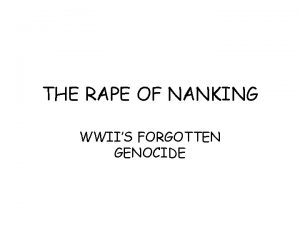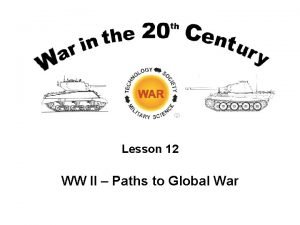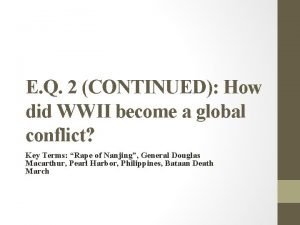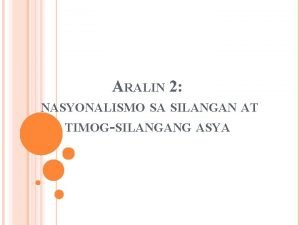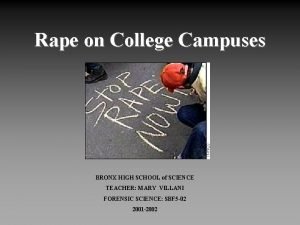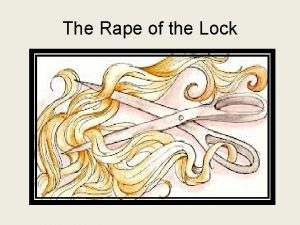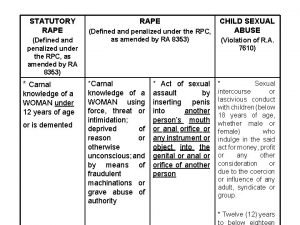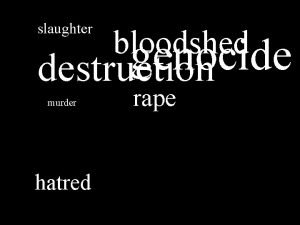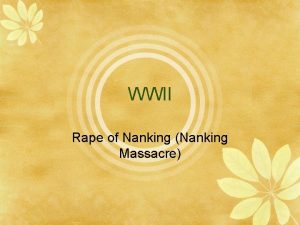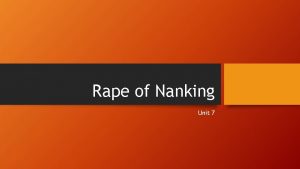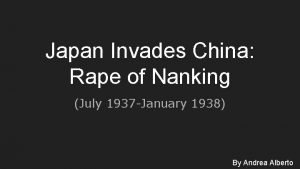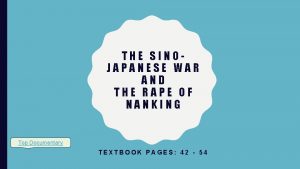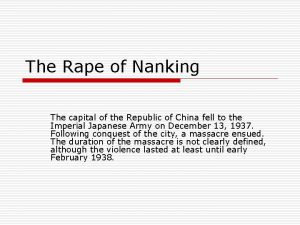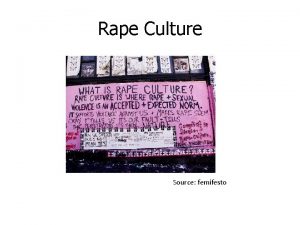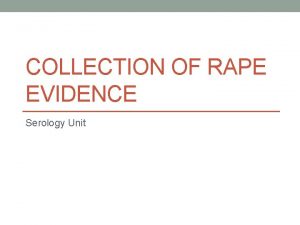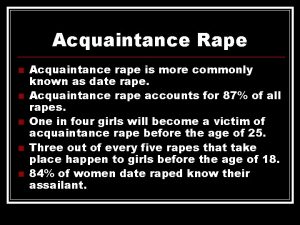The Rape of Nanking A POWER POINT PRESENTATION
























- Slides: 24

The Rape of Nanking A POWER POINT PRESENTATION BY: MR. MENDOZA SUNNYSIDE HIGH SCHOOL


Imperialist Japan signs treaties under League of Nations to limit imperialist activity, 1922 -1928 Political chaos in interwar Japan, assassinations Militarist, imperialist circles advocate greater assertion of Japanese power in the region China a soft target

The Mukden Incident (1931) Japanese troops in Manchuria, China, secretly blow up small parts of the Japanese-built South Manchuria Railroad as pretext for war Over opposition of Japanese civilian government, military takes Manchuria, renames it Manchukuo, a puppet state League of Nations censures Japan, Japan leaves the League of Nations

History In 1928, the Chinese Nationalist Government moved the capital of China from Peking (Beijing) to Nanking. The city normally held about 250, 000 people, but by the mid-1930 s its population had swollen to more than 1 million. Many of them were refugees, fleeing from the Japanese armies which had invaded China.

The Capital Falls On November 11, 1937, after securing control of Shanghai, the Japanese army advanced towards Nanking from different directions. In early December, the Japanese troops were already in the outskirts of Nanking. On December 9, the Japanese troops launched a massive attack upon the city. On the 12 th, the defending Chinese troops decided to retreat to the other side of the Yangtze River (Yangzi Jiang).

The Capital Falls On December 13, the 6 th and 16 th Divisions of the Japanese Army entered the city’s Zhongshan and Pacific Gates. In the afternoon, two Japanese Navy fleets arrived.

Japanese Domination In less than 6 weeks, Japanese soldiers executed between 300, 000 and 350, 000 Chinese soldiers and civilians. Between 20, 000 – 80, 000 women raped, mutilated and killed.

Cruelty the Commonplace Ø Japanese soldiers took great pleasure in committing these crimes. Ø Supported by commanding officers. Ø Bragged and boasted of mutilation of Chinese.

Assault on Humanity Women as young as 7 and as old as 70 were raped, often on multiple occasions. Women were raped in front of their spouses, children, or parents. When soldiers were done raping, they would mutilate the female body.

Cruel Games Ø Attacks on women were supposed to boost morale of soldiers. Ø Soldiers would have killing competitions to boost morale as well. Ø Warning: The following images are graphic and may be unsettling to view.



Decapitated heads on display for Japanese soldiers









“One of the great atrocities of modern time” ØTillman Durdin of the New York Times reported mass executions. ØReported seeing 200 Chinese executed in 10 minutes. ØLive bodies doused with gas or oil and set on fire. Burned alive.

Sources http: //news. bbc. co. uk/1/hi/world/223038. stm http: //www. princeton. edu/~nanking/ http: //www. bergen. org/AAST/Projects/China. Histor y/rape. html http: //www. exploratorium. edu/nagasaki/ http: //www. ushmm. org/museum/ http: //www. cnd. org/njmassacre/ http: //research. unc. edu/endeavors/win 97/comfortl. html
 Rape of nanking def
Rape of nanking def Rape of nanking
Rape of nanking Rape of nanking
Rape of nanking Nanking
Nanking Ano ang layunin ng rebelyong taiping
Ano ang layunin ng rebelyong taiping Rpe of nanking
Rpe of nanking Topics for powerpoint presentation for class 4
Topics for powerpoint presentation for class 4 Power point presentation design west vancouver
Power point presentation design west vancouver Draw the power triangle
Draw the power triangle Informsu
Informsu Point point power
Point point power Clarissa's speech canto 5
Clarissa's speech canto 5 Rape of the lock as a mock epic
Rape of the lock as a mock epic Bronx science rape
Bronx science rape Rape o
Rape o Rape fantasies margaret atwood
Rape fantasies margaret atwood Rape underage porn
Rape underage porn Un vieux pardessus
Un vieux pardessus A rape in cyberspace
A rape in cyberspace Fairest of mortals thou distinguish'd care
Fairest of mortals thou distinguish'd care Statutory rape rpc
Statutory rape rpc Rape of the lock as a social satire
Rape of the lock as a social satire Rape crisis south london
Rape crisis south london Long term effects of rape
Long term effects of rape Rape
Rape
